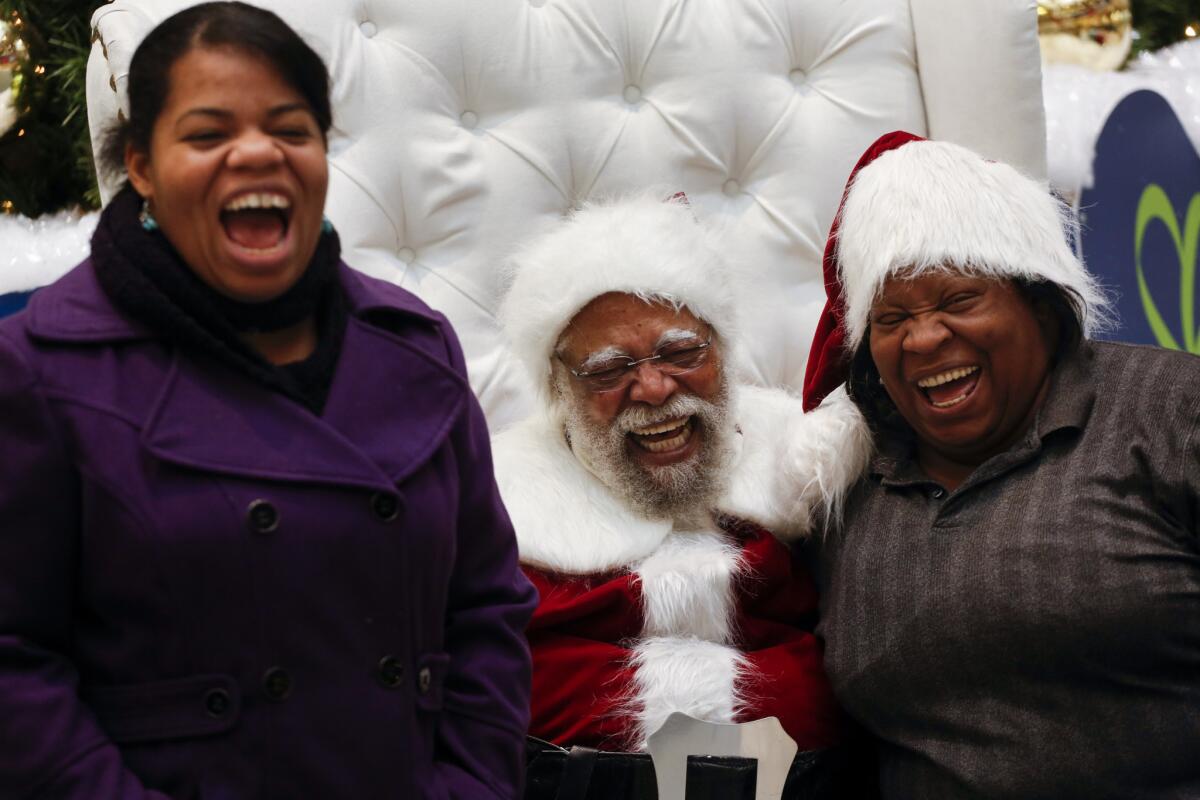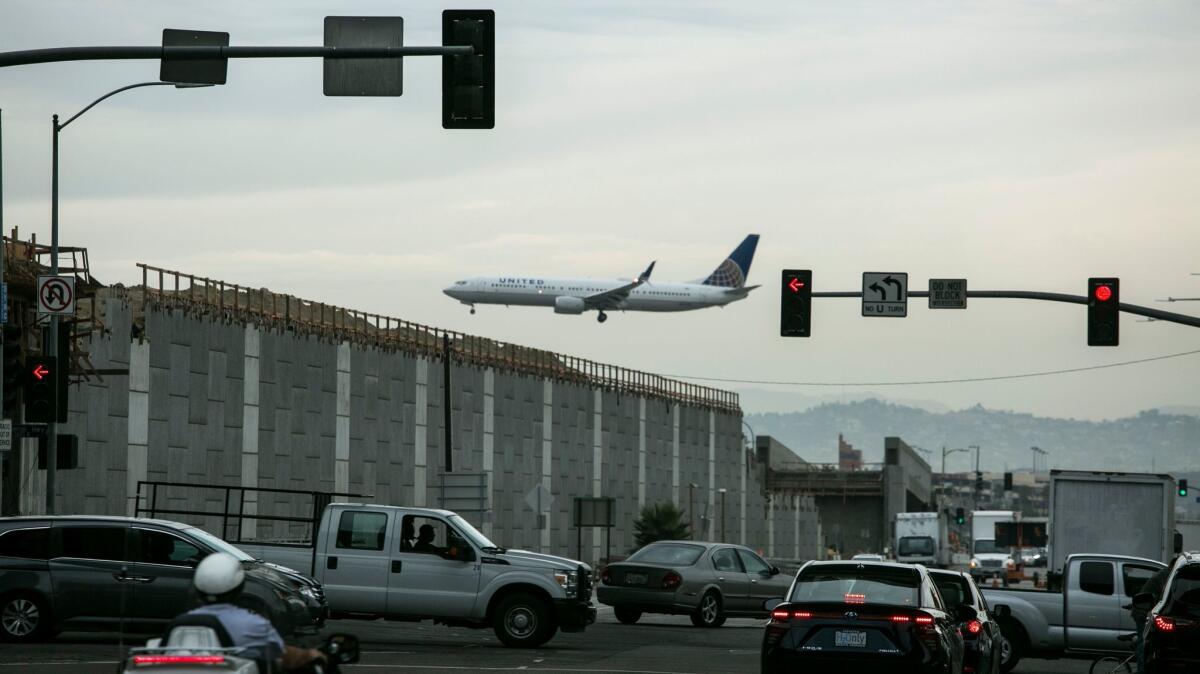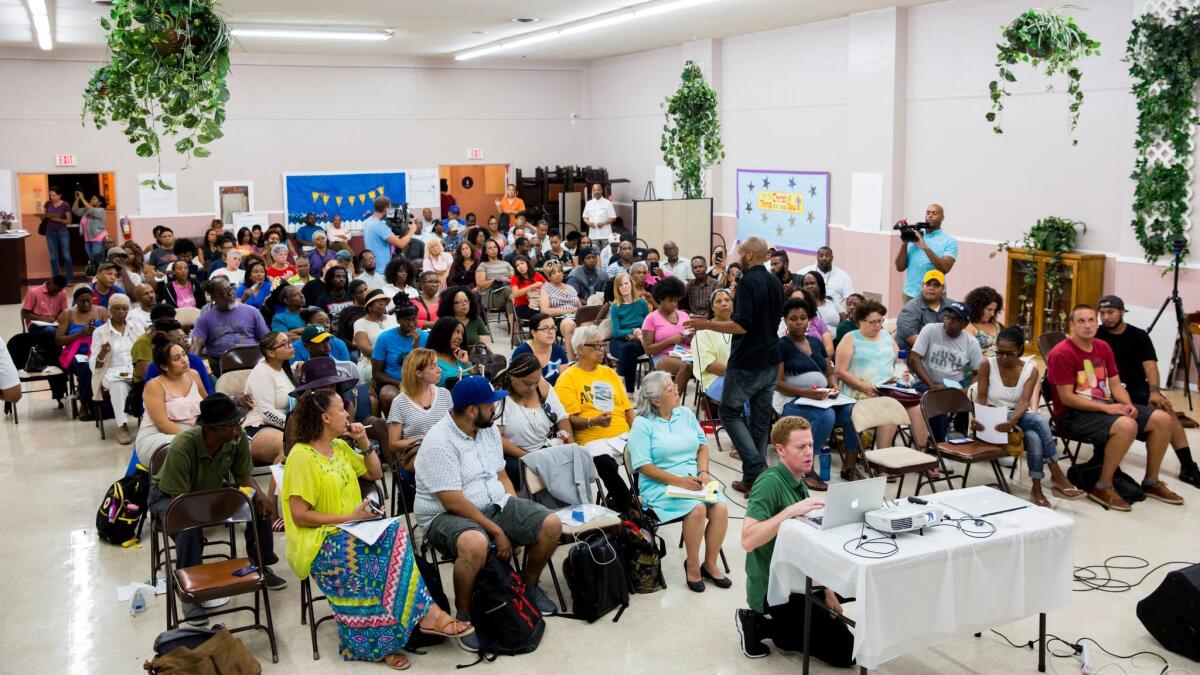This L.A. mall is famous for its African American Santa Claus. Can it survive gentrification?

- Share via
Justin Jackson jumped at the chance to move his photography studio from downtown L.A.’s Arts District into a historic black community off Crenshaw Boulevard where he grew up.
Encouraged by the prospect of new development and increased foot traffic, he relocated last year and from his storefront he can hear the beats of the African drum circle that meets Sundays in the neighborhood square.
The area “is due for an upgrade, and I think we’re seeing that upgrade come to fruition with the Metro going through and the shopping center,” Jackson said, adding “I’m open to development, I’m open to diversity.”
Over the past few years, the forces of gentrification have begun to move south, from downtown, Echo Park and Koreatown into the Crenshaw District, the heart of L.A.’s black community, pushing up real estate values and grabbing the attention of new retailers and residents.
But ambitious plans to transform what many consider the heartbeat of the neighborhood has residents wrestling with Crenshaw’s evolving identity.
The 70-year-old Baldwin Hills Crenshaw Plaza may soon be approved for a major redesign that would cost up to $700 million and include more than 900 housing units — most of them market rate — new retail shops, restaurants, office space and other amenities.
The mall was for decades a center of life in Southwest L.A. and a point of pride for blacks in the city who long decried the lack of chain business and restaurants willing to move into the neighborhood. At Martin Luther King Jr. and Crenshaw boulevards, the mall has offered suburban-style shopping with an African American twist and is famous for having a black Santa Claus on hand during the holidays to take photos with children.

But like many malls, the Baldwin Hills Crenshaw Plaza is looking to remake itself in the face of downsizing by major retailers and increasing online sales. It’s long been the case that more affluent communities of black professionals near the mall have tended to do their shopping elsewhere.
Many worry that the plan to revitalize it could price out long-term residents and small businesses while also erasing the area’s legacy of black culture and history. Others, like Jackson, see new opportunity. Some question whether the impact is negative if it’s being driven by other African Americans.
“Now I’m confused about what the definition of gentrification means,” said Misty Wilks, a bankruptcy attorney in Leimert Park. “Because it used to mean white people running into black people’s neighborhoods and taking over. But our [mall] developer is black … and we’re in a neighborhood full of black people.”
“We keep yelling gentrification when black people are buying and selling property and making money and being successful,” she said.
But Jackie Ryan, owner of Zambezi Bazaar in Leimert Park, said she sees something more troubling: now-vacant storefronts that used to house small, family-owned businesses until rents began spiraling.
“Market rate rents would drive everyone out of here,” Ryan said.
Tara Mason, a public school teacher who grew up in nearby View Park, said she sympathizes with both sides of the debate.
“I used to take cabs and shuttles before, and now anyone in the community will be able to jump on the Metro and go to the airport,” she said. “That’s something everyone in the community wants to take advantage of.”

But Mason said residents also feel that investment in the area has been a long time coming and may benefit newcomers rather than long-timers. Resentment has been stoked by an influx of white residents seeking character homes that are far more affordable than real estate on the Westside and other areas.
“[They are] feeling like it was set up for somebody else to have, that it wasn’t something that they could have because the money wasn’t there for them,” she said. “It wasn’t earmarked for that type of community.”
Revitalizing the mall is a big piece of a larger transformation occurring in the area. The Crenshaw/LAX light-rail line with a Leimert Park station is set to open in 2019. Kaiser Permanente medical offices opened in early September. And other big developments are also planned.
Alexandra Mendoza-Graf, an assistant policy researcher at the RAND Corp., said that a shortage of affordable housing makes it difficult for many residents to stay in their communities, and that the development of light-rail lines may contribute to gentrification.
“You’re seeing younger, more educated families moving into neighborhoods around the Expo Line (running from downtown L.A. to Santa Monica) that have traditionally been neighborhoods that are lower income,” she said. “It’s changing the demographics of those neighborhoods, and the values of homes and housing is rising in those areas.”
While some neighborhoods — like Boyle Heights — have pushed back against gentrification, Mendoza-Graf said some lower-income communities have a harder time organizing resistance.
“In L.A., you’ve seen communities that aren’t able to organize and protect themselves against the effects and communities that have a strong will or ability to organize,” she said. “I think those will see fewer effects of gentrification or find some ways of mitigating the effects.”
African Americans began moving to the Crenshaw District and nearby Baldwin Hills in the 1950s after the Supreme Court nullified racially restrictive housing covenants. Leimert Park has long been occupied by black middle- and working-class residents. But the median housing price in Baldwin Hills and Leimert Park more than doubled in five years and reached about $670,000 in May, according to real estate data firm CoreLogic.
Carolyn Hull, vice president of Industry Cluster Development at the Los Angeles County Economic Development Corporation, said the Crenshaw area is seeing development — retail, housing, dining — that is typical in communities located near public transportation.
“Once you put a billion dollars into an area and enhance the infrastructure, you see a lot of private investment following,” she said. “Clearly there’s always been a misconception about the lack of buying power in the community that has held back some investment of areas such as retail.”
But the complexion of the area is also changing. The number of African Americans living in the immediate vicinity of the Baldwin Hills mall has declined since 2000, while the populations of Latinos, non-Hispanic whites, Asians and homeowners have increased, according to Paul Ong, director of the Center for Neighborhood Knowledge at UCLA’s Luskin School of Public Affairs.
“The challenge facing this particular area is how to manage some of those changes so the benefits are generated in a way that it doesn’t just displace people who cannot afford to remain there,” Ong said.
A forum billed as a session to address gentrification attracted hundreds, including residents and community leaders who feared the impact of the mall plans, to a Hyde Park church in early August.

Standing in front of the packed room, Crenshaw Subway Coalition founder Damien Goodmon, one of the event’s organizers, told the audience, “Repeat after me: ‘Market rate means not for me.’”
The city should examine how the shopping mall’s redevelopment plan would affect low-income residents, demand more local hiring and push for more affordable units, he said.
Currently, 10 percent of units are designated for low- and median-income housing.
Khalil Edwards, organizing director of the Los Angeles Black Worker Center, said that is not good enough.
“Among this black community, you have different class statuses,” Edwards said. “You have folks who have higher income, [are] middle class and are homeowners that are able to stay, and then you have folks that are making a living wage and are worried if they’re going to be able to afford their rent in a few months.”
Quintin Primo of Capri Investment Group, a minority-owned firm in Chicago that owns the mall, said calculations for lower-income housing were based on what is “economically feasible” and necessary to attract investors for the project.
“We haven’t seen a long line of developers or investors that are willing to make this type of investment in South L.A. or the Crenshaw corridor,” Primo said.
The developer has said that it already hires locally. Plans for the new mall include an on-site job-training center.
City Councilman Marqueece Harris-Dawson, whose district includes Crenshaw, said the mall development will improve residents’ access to goods and services.
“I think it’ll be a breath of fresh air after a long period of disinvestment and redlining and a whole bunch of other measures that haven’t added up to serious investment in our area, even though the numbers have been there to support it for more than a decade,” he said. “The incomes have been there, the traffic has been there, the customer base has been there.”
He acknowledged concerns about gentrification but said that displacement should be addressed with rapid rehousing and supportive programs to prevent evictions — not by resisting development.
“There’s an unsettling amount of push-out already happening, [and] my expectation is even if a single stick or brick isn’t put on the Baldwin Hills mall, it will continue because of the real estate situation in Southern California,” he said.
Other community leaders are excited about redevelopment.
“This is a wake-up call to African Americans to get your financial health in order and join this capitalist train and move forward, because the train is already coming down the boulevard, literally,” said Carl Morgan, chairman of the Empowerment Congress West Area Neighborhood Development Council.
He’s also satisfied with the housing plan.
“Why should we [South L.A.] always be the dumping ground for affordable housing? We need more market-rate housing so we can get the types of services that our residents have been screaming for for decades.”
Others, though, are still bitter that development comes after decades of inattention. Chas Taylor grew up in West Adams — hanging out in the Crenshaw area as a youth — but recently moved to Palm Desert after struggling to find affordable housing in Los Angeles.
“They kept that neighborhood oppressed for all these years, wouldn’t give people loans, the police services were crap,” he said. “They allowed drugs and gangs, and now all of a sudden, the train is coming down Crenshaw.”
Follow @leilamillersays on Twitter
ALSO
This chef is betting that people in Hong Kong will learn to love Mexicali food
More to Read
Sign up for Essential California
The most important California stories and recommendations in your inbox every morning.
You may occasionally receive promotional content from the Los Angeles Times.











